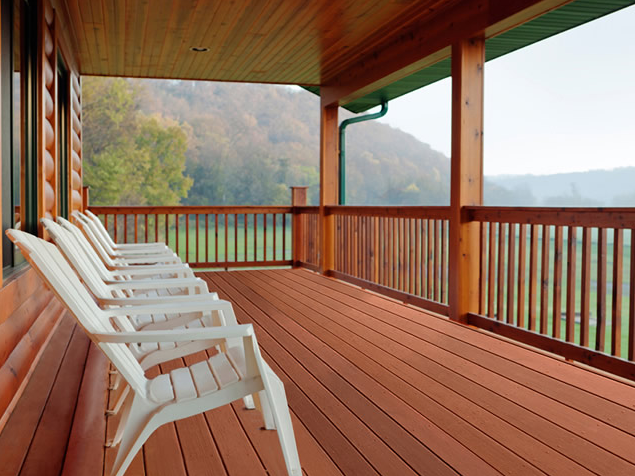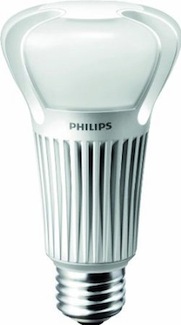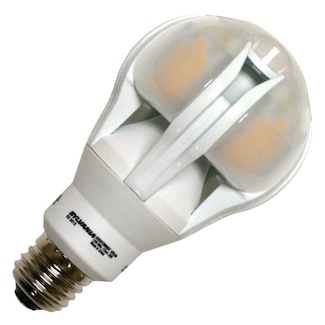100-Watt Equivalent LED Light Bulbs
LED light bulbs are quickly catching on with the public, and for good reason; they use up to 80% less electricity for the same amount of light compared to traditional incandescent bulbs. The light they produce is of a higher quality than efficient compact fluorescent bulbs, much closer to incandescent light. And unlik CFLs, LED bulbs contain no mercury, lead, or other harmful materials. They also last much longer than CFLs (up to 22 years of normal use!) and can be used with dimmers. Most LED bulbs on the market today are designed to replace 40, 60, or 75 watt incandescent light bulbs. Until recently, the 100-watt equivalent LED bulb has been elusive; the high temperatures of brighter LEDs require a design that dissipates heat so as not to significantly shorten the bulbs' lifespan.
Now, newer bulbs are reaching the market that achieve the brightness of 100-watt incandescents, using as little as 19 watts! While they are still quite a bit more expensive than CFLs or incandescents, their extreme efficiency and ultra-long lifespan make then a worthwhile investment (and their prices are expected to drop dramatically as their production scales up in the coming few years.)
Let's take a look at a couple of these newer, brighter bulbs from industry leaders Philips and Sylvania.
Philips 19-Watt A21 LED Bulb
Philips has been a leader in new LED bulb technology for several years. Their L-Prize bulb was the first to win the U.S. Government's L Prize competition for innovative LED bulb design, using only 10 watts of power to create light equivalent to a 60 watt incandescent. The new 19-watt A21 bulb is an evolution of the L-Prize bulb, using many of the design features and technology to create warm, bright light (equivalent to a 100-watt incandescent) using only 19 watts.
Extreme Energy Savings with the Philips 19-Watt A21 LED Bulb
Using only 19 watts of power, the Philips A21 bulb creates the bright light often needed and wanted in the home while realizing substantial energy savings and the resulting money savings. Over its long life, the Philips A21 bulb will save its owners over $220 (based on average U.S. energy costs.)
Sylvania 20-Watt A21 LED Bulb
Similar in performance to the Philips 19-watt A21 LED, the new Sylvania 20-watt A21 bulb features a slightly different design, while still providing the same amount of light as a 100-watt incandescent bulb.
Benefits of the Sylvania and Philips A21 LED Bulbs
Both the Philips and the Sylvania A21 100-watt equivalent LED bulbs offer similar light quality. Their light is soft and warm, very similar to the light from an incandescent bulb.
Some of their other benefits:
- Extra Long Life: Like other LED bulbs, these A21 bulbs, though brighter, will still last a long, long time. Under normal conditions, their lifespans should run up to 25,000 hours, or 23 years.
- 75% Less Energy Usage: These bulbs create the same amount of light as a 100 watt incandescent bulb, but use 75% less energy. This reduction can save their owners over $220 over the life of the bulb. Their lower energy usage also creates much less pollution and climate-changing emissions from fossil-fuel power plants.
- Mercury-Free: Unlike CFL bulbs, LED bulbs contain no mercury. These LED bulbs are also lead-free and contain no harmful materials at all.
- Dimmable Performance: Also unlike most CFLs, these LED bulbs are dimmable down to 5 or 10% of their full-strength light. This allows for further energy savings as well as usage in a variety of locations and settings.
- Omni-Directional Light: Some earlier LED designs sent light mostly upward, limiting their usefulness in lamps. These newer LED bulbs are omnidirectional, sending light outward, upward, and downward just like an incandescent bulb.
As mentioned earlier, the costs for these new, high-tech LED bulbs are much higher than other types of bulbs, but their energy savings and use will save many times their cost over time. The Philips bulb is available for $45; the Sylvania is a few dollars more at $48 (as of Nov. 2013). As the LED market grows and matures, they will soon become the light bulb of choice for millions of Americans looking to save on lighting costs and reduce pollution levels. They're a win-win any way you look at them.
comments powered by Disqus









































































































































